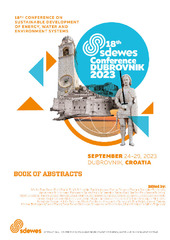Приказ основних података о документу
Modelling the long-term dynamics of the energy transition accounting for socioeconomic behaviour and biophysical constraints: overview of the Wiliam Energy Module
| dc.creator | Eggler, L. | |
| dc.creator | Capellan-Perez, I. | |
| dc.creator | De Blas, I. | |
| dc.creator | Alvarez Antelo, D. | |
| dc.creator | Adam, A. | |
| dc.creator | Papagianni, G. | |
| dc.creator | Parrado-Hernando, Gonzalo | |
| dc.creator | Herc, Luka | |
| dc.creator | Pulido-Sanchez, D. | |
| dc.creator | De Castro, C. | |
| dc.creator | Frechoso, F. | |
| dc.creator | Cazcarro, I. | |
| dc.creator | Arto, I. | |
| dc.creator | Samso, R. | |
| dc.creator | Duić, Neven | |
| dc.creator | Batas Bjelić, Ilija | |
| dc.creator | Pfeifer, Antun | |
| dc.date.accessioned | 2023-12-28T20:18:55Z | |
| dc.date.available | 2023-12-28T20:18:55Z | |
| dc.date.issued | 2023 | |
| dc.identifier.issn | 2706-3690 | |
| dc.identifier.uri | https://dais.sanu.ac.rs/123456789/16220 | |
| dc.description.abstract | WILIAM (Within Limit Integrated Assessment Model) is a global multiregional IAM that combines economic, social, demographic, environmental, energy and material related aspects into one system dynamics model. It aims to provide stakeholders with an open source, welldocumented model to assess the feasibility, effectiveness, costs and impacts of different sustainability policy options. The adequate representation of energy production is key to assess future sustainability pathways. The main function of the developed energy module is to estimate the primary energy requirements and related GHG emissions for satisfying the economic demand. This goal was achieved by 7 major sub-modules: (1) End-use: translates the economic demand into final energy demand through a hybrid approach combining bottom-up with energy intensities for different sectors. (2) Energy transformation: maps the entire energy conversion chain from final to primary energy, including intermediary energy commodities and an allocation function for power plant utilization. (3) Energy capacity: keeps track of the current power plant capacity stock, decommissioning of expired capacities, as well as the build-up of new capacities. An allocation function for choosing the suitable technology types for new capacities stands at the core of this sub-module. (4) Computation of the EROI of green technologies (5) Variability and storage: keeps track of sub-annual time scale effects on annual energy balances depending on the current power system setup (DSM, Storage, sector coupling). (6) Consideration of techno-sustainable potentials of RES considering geographical, resource and Energy Return on Energy Investment (EROI) constraints. (7) Computation of the energy-related GHG emissions. | sr |
| dc.language.iso | en | sr |
| dc.publisher | Zagreb : Faculty of Mechanical Engineering and Naval Architecture | sr |
| dc.rights | openAccess | sr |
| dc.rights.uri | https://creativecommons.org/licenses/by/4.0/ | |
| dc.source | Book of abstracts / 18th conference on sustainable development of energy, water and environment systems, September 24-29, 2023, Dubrovnik, Croatia | sr |
| dc.subject | Within Limit Integrated Assessment Model | sr |
| dc.subject | energy production | sr |
| dc.subject | energy transition | sr |
| dc.title | Modelling the long-term dynamics of the energy transition accounting for socioeconomic behaviour and biophysical constraints: overview of the Wiliam Energy Module | sr |
| dc.type | conferenceObject | sr |
| dc.rights.license | BY | sr |
| dc.citation.spage | 151 | |
| dc.citation.epage | 151 | |
| dc.type.version | publishedVersion | sr |
| dc.identifier.fulltext | http://dais.sanu.ac.rs/bitstream/id/64367/Eggler_SDEWES2023ibb-3.pdf | |
| dc.identifier.rcub | https://hdl.handle.net/21.15107/rcub_dais_16220 |

